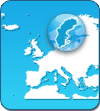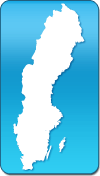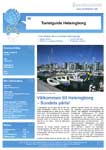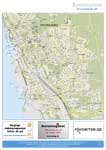Welcome to Helsingborg – The Sounds Pearl!
In Helsingborg, you can here what you cannot do anywhere else in the world - you can see the coasts of two countries at the same time while you watch the sun set between them. Our coastline is 23 kilometers long. Helsingborg lies along the eastern shore of the narrowest part of the Sound, so it is easy to understand how attractive the city is to live and work. The sea is present everywhere.
The proximity to Europe means a lot to the people of Helsingborg. Here everything is well within reach and is also a fine mixture of a large city along with a charming small town feeling. Here is our history and here is our future. “The Sounds Pearl”, well known and referred to mainly the “beautiful place” with the magnificent rhododendron on Sofiero, the fragrant rose garden at Fredriksdal open-air museum, the many long sandy beaches, all the cafes, restaurants and shops, the wide range of museums at Dunkers Culture House, the internationally recognized Symphony Orchestra, the reputed City Theater, the excellent sports facilities with the football team HIF’s Olympia and of course, all the ferries going back and forth across the Strait. In each direction, it is year-round about 125 ferries per day. Nowhere else can a person “feel lucky” as we do in Helsingborg! Moreover, we actually consider Copenhagen our capital.
Municipality Facts
Population
125 000
Area
347,23 km²
Regional Center
Helsingborg
County
Skåne
More Information
Internet
www.helsingborg.se
Newspapers
Helsingborgs Dagblad/NST/Landskrona-Posten www.hd.se
Tourist Bureaus
Helsingborgs Tourist Bureau Open Monday-Friday, 10-18, Saturdays 10-14 Open everyday during the summer, weekdays 9-20, see actual details on our website. Rådhuset, Helsingborg +46 42-10 43 50 turistbyran@helsingborg.se www.helsingborg.se
Notes
Emergency
112
Police
114 14
Country Code
+46
Area Code
042
City
About
Welcome to Helsingborg – The Sounds Pearl!
In Helsingborg, you can here what you cannot do anywhere else in the world - you can see the coasts of two countries at the same time while you watch the sun set between them. Our coastline is 23 kilometers long. Helsingborg lies along the eastern shore of the narrowest part of the Sound, so it is easy to understand how attractive the city is to live and work. The sea is present everywhere. The proximity to Europe means a lot to the people of Helsingborg. Here everything is well within reach and is also a fine mixture of a large city along with a charming small town feeling. Here is our history and here is our future. "The Sounds Pearl", well known and referred to mainly the "beautiful place" with the magnificent rhododendron on Sofiero, the fragrant rose garden at Fredriksdal open-air museum, the many long sandy beaches, all the cafes, restaurants and shops, the wide range of museums at Dunkers Culture House, the internationally recognized Symphony Orchestra, the reputed City Theater, the excellent sports facilities with the football team HIF's Olympia and of course, all the ferries going back and forth across the Strait. In each direction, it is year-round about 125 ferries per day. Nowhere else can a person "feel lucky" as we do in Helsingborg! Moreover, we actually consider Copenhagen our capital.
History
Det historiska Helsingborg
In 1085, Helsingborg was first mentioned in a deed and as a gift from the Danish king, Canute IV of Denmark. Skåne was Danish up until 1658. The simple fort made of wood was replaced in the 1100's by a castle and a town was built around it with three churches and a monastery. During the Middle Ages, Helsingborg was an important city for the Danish Kingdom. The Reformation in the 1500s broke up the monastery and the Catholic churches which weakened the settlement and the proud palace was no longer able to resist an attack. The 1600s became a painful century. Denmark and Sweden were often at war. Six times the Swedes conquered the city, but lost the same number of times to the Danes. During the Danish-Swedish War, 1675-1679, a large part of the city was devastated. Only Mary and Jacob Hansen's House was spared. The castle fell. The only thing that had been left in place was the tower from the 1300's. It was not until the Battle of Helsingborg in 1710, one of the bloodiest ever on Swedish soil, the Danes were finally defeated. Magnus Stenbock led the Swedish forces. In memory of battle, a statue was erected at the large square in 1901. However, it was not until the industrial development in the mid 1800s that the city began to flourish. The port was built, the railways were built and industries grew up. Four important men in "the city council" Helsingborg would not be what it is today without the consuls Petter Olsson, Nils Persson and Oscar Trapp and the manager of Rubber factory, Henry Dunker, in the late 1800s and early 1900s. The three consuls sat on the City Council and took a very active part in the transformation of the city's port, building up the industry and the railway. Several companies in Helsingborg still have their founding roots by Petter Olsson, or Nils Persson. Petter Olsson (1830-1911) Petter lost his father early and inherited his mother's religiosity and fairness, which followed him throughout his life. At just 23 years old, he founded a grain firm and soon became the country's largest oat exporter. Ports, railways and factories were built, thanks to Peter Olsson. The memories from his poor childhood influenced him to start two orphanages for orphans and poor children. In 1870, he purchased Rögle farmhouse and brickyard, and was appointed to the German consul. He fought for a rail to Hässleholm and it was inaugurated 1875. The railway north was inaugurated ten years later. Olsson was eloquent and managed to buy land from farmers so that these advancements could be realized. In 1892, the railway ferry to Elsinore opened with two Danish ferries. It was the Consul Olsson that in 1891 founded Helsingborgs Rubber Factory. In 1894, Henry Dunker took over the factory after his father, and bought five years later from Consul Olsson. He served forty years on the City Council, and the last fifteen as its chairman. Nils Persson (1836-1916) He began his career as shop assistant in 1861, before he started a multi-department store. Success gave birth to success. Just as Petter Olsson, he took the risk in large capital. In one project, they went together and founded Helsingborgs Sugar Company. As a symbol, the factory wall had both companies on it. Nils Persson was able to find the right specialists. In 1875, he realized the importance of fertilizer and built Skånska Superfosfat and Svavelsyrefabriksaktiebolaget, commonly referred to as Phosphates. Today's Kemira has its roots in this company. In 1875, he was appointed to the Dutch consul and 1894, he succeeded Petter Olsson as a German consul. In 1885, he moved to what is today known as Konsul Persson's villa, which is now a student campus. In 1903, he took over shareholding in Ramlösa Brunn AB. He served thirty-two years on the City Council and succeeded Olsson as chairman in 1904, which he then held for four years. Oscar Trapp (1847-1916) He was involved in banking and real estate transactions. When the major renovation of Kärnen (medieval tower) was launched in 1893, he submitted a motion of a monumental staircase between the castle and the large square.. A sketch by the architect Alfred Hellerström was annexed and the City Council decided to go ahead with the idea. In 1903, Stockholms architect Gustaf Améen won and inaugurated the stairs. Of course, the spot below the stairs is called Konsul Trapps place. Oscar and Gisela Trapp owned Fredriksdal. In 1918, Gisela's widow donated the entire property to City of Helsingborgs and moved to Arild. However up until 1937, she lived periodically in the Manor at Fredriksdal. The goods would be preserved and the land would run as an open-air museum. Mr and Mrs Trapp would probably not be disappointed if they could see their Fredriksdal today. Gisela Trapp died in 1958. Oscar Trapp was also the man behind the Swedish flag, which at that time was much darker than today's. As a member of Parliament, he motioned that the flag must have specific colors. In 1906, it was enacted and the flags colors became brighter and was launched throughout the country. Henry Dunker (1872-1962) Often called the "galoschkungen" (Galosh King) by the people of Helsingborg, and in 2000, he was appointed "Helsingborger of the Last Millenium". It says a lot. Despite his relative anonymity, he was a peculiar and inaccessible man, dressed in a derby, a necktie and specially designed rubbers, there are still people who remember him, with ratings ranging from the highest esteem to the most brutal and with harshness. In addition to almost seven decades of running the successful Gummifabrik (later Tretorn), he realized the importance that a city must have a rich cultural life for the industry to flourish. He was one of those who financially contributed to the construction of the Concert Hall. Above all, he made themselves immortal through the Henry & Gerda Dunkers Donation Foundation and at the time of death he left 58 million for cultural investment in the city, money that is well managed. So far the Fund has paid for the construction of the City Theater, Kulturmagasinet, Graphic museum, the grandstand at Olympia, and - to top it all off- Dunkers Culture House! Some say the city has a gold mine to spend! Yet it is not exhausted. Thank you, Henry & Gerda dunker!
See and Do
Swimming
Bathing
In Helsingborg there are many wonderfully shallow and child-friendly beaches.
Family Activities
Dunkers Culture House
At the Dunkers Culture House you will find an art gallery, the city and cultural history exhibitions, music, theater, youth culture, shop, the fact room, restaurant and bistro. Visit our website for more information. Kungsgatan 11, Helsingborg +46 42-10 74 00 www.dunkerskulturhus.se
The Bird Park
The Bird park has more than 500 birds and more than 100 species are represented. Admire all the Kakaduor, Ara and Parakeets, or get even a more closer look at some of the more rare species. Rausvägen 671, Helsingborg +46 42-22 84 80 www.fagelparken.se
The Tropical House
Here you can see animals from many parts of the world. Hävertgatan 21, på Stattena i Helsingborg +46 42-13 00 35 www.tropikariet.com
Fishing
Fiske
Information on where to fish can be found at the Tourist Office. From Helsingborg and Råå, fishing charters are offered everyday and all year round for fishing in the Sound.
Guest Harbour
Guest Harbors
www.norrahamnen.helsingborg.se www.rhss.m.se www.domstensbatklubb.se
Museum
Beredskapsmuseet (Readiness Museum)
Beredskapsmuseet is the only museum in Sweden, which is located in an underground military facility. A visit here tends to be a day to remember. Here you can experience what it was like during World War II in Sweden. On display are artillery pieces, photographs, uniforms and the 30 ton cannon, Maja. In addition to all the exciting exhibitions at the museum in their real environment, is a fantastic nature. From the roof of the cannon Majas bunker, you can see both the Sound and the surrounding area a couple of miles in all directions. Directions: Take road 111 towards Höganäs/Helsingborg from E6 or E4. Follow road 111. Reference signs are shown for "Beredskapsmuseet" on road 111, 8 km from Höganäs. 13 km from Helsingborg. OBS! It is a very small sand road leading to the museum. Drive carefully! +46 42-22 40 39 www.beredskapsmuseet.com
Dunkers Culture House
Dunkers Culture House is a meeting place for culture in the Sound region. Here are parts of Helsingborgs museum collections, art gallery, theme exhibitions, concert hall and theaters. It offers a wide range of both local and visiting artists and ensembles. Kungsgatan 11, Helsingborg +46 42-10 74 00 www.dunkerskulturhus.se
Graphic Museum
The Graphic museum is Sweden's largest print museum. Here you can see how handmade paper becomes a work of art, see napkins with monograms in gold, see how a book is made by hand, and much more. Fredriksdal: Gisela Trapps väg 5, Helsingborg +46 42-10 45 24 www.grafiskamuseet.se
Helsingborgs Medical History Museum
Helsingborgs Medicine Museum is located in the old Children's Hospital from 1888 which has been restored to its original condition. The museum displays health care from all over the 1900s and also has a library and auditorium. Bergaliden 20, Helsingborg +46 42-10 12 79 www.medhist-hbg.se
Helsingborgs Sport Museum
Here you can see Helsingborgs own sport history with athletes such as Kalle Svensson, Gunnar Nilsson, and Henrik Larsson. Carl Krooks Gata 10, Helsingborg +46 42-13 39 00 www.idrottsmuseum.org
Råå Museum for Fisheries and Maritime Affairs
Råå Museum is a museum for Fisheries and Maritime Affairs, which tells the story of fishermen and sailors. In the museum are shipping charters, models, a decorated Captains Quarters, an old ship store, a decorated older Råå home and much more. Hamnplan, Råå +46 42-26 11 31 www.raamuseum.se
Nature
Nature Reserve
The closest national park can be found at Söderåsen, a couple miles east of Helsingborg, mainly in Klippans municipality.
Nature Reserve
Kullaberg, is located in Höganäs municipality, which is north of Helsingborg, and a large nature reserve.
Parks
Fredriksdal Museums and Gardens
Fredriksdal offers experiences for all ages. Here are museums and fantastic gardens. Gisela Trapps väg 1, Helsingborg +46 42-10 45 00 www.fredriksdal.se
Sofiero Castle and Garden
Sofiero Castle was built in 1865 by the Crown Prince Oscar and his wife Sophia. It was built as a summer castle for the family and they stayed there over summers. Even Gustav VI Adolf stayed here during the summers. The famous collection of rhododendrons are still grown here along with Crown Princess Margaretas' incredible flower garden. Now, the castle is one of Helsingborgs' largest tourist attractions, with many visitors from Sweden and abroad - especially during May-June when the rhododendron are in full bloom. There is also and open-air garden. The Castle even offers garden exhibitions and outside concerts. Sofierovägen 57, Helsingborg +46 42-13 74 00 www.sofiero.se
Events
Other
Yearly Events and Celebrations
Celebrations! Spring city run 10 km National Day Celebrations in Fredriksdal Summer theater with Eva Rydberg at Fredriksdal open air theater Midsummer celebration at Fredriksdal and Sofiero Helsingborgs Festival Antique Fair at Idrottens Hus (Sport House) Boat Fair in the North Harbor and The Big Crayfish Party at Henry Dunkers place The Big Garden Party at Sofiero Mikaeli Market at Fredriksdal The Christmas Sprit at Sofiero Christmas at Fredriksdal
Source
- Helsingborgs Turistbyrå
- www.kommunernaskalender.com
- www.eurotourism.com
- www.dagspress.se
Med reservation för eventuella ändringar
Search companies in Helsingborg
Search Result
Found 1 matches
| Hotell Linnea042-372400Prästgatan 2-4, HELSINGBORG |  |






 Dansk
Dansk Deutsch
Deutsch English
English Suomi
Suomi Français
Français Ελληνικά
Ελληνικά Íslenska
Íslenska Nederlands
Nederlands Norsk
Norsk Português
Português Svenska
Svenska 简体中文
简体中文 繁體中文
繁體中文 Español
Español Italiano
Italiano 日本語
日本語 한국어
한국어 Polski
Polski Русский
Русский Türkçe
Türkçe
